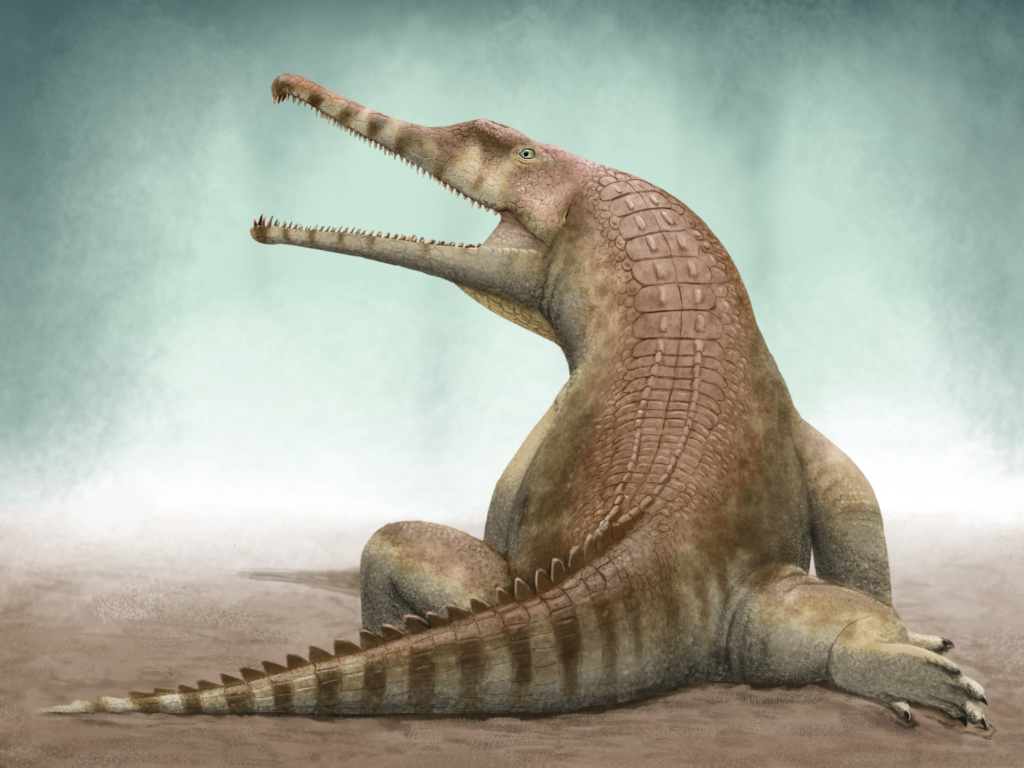In the annals of prehistoric creatures, few animals challenge our understanding of evolution as dramatically as Batrachopus grandis—the ancient crocodile that walked on legs resembling those of a Tyrannosaurus rex. Unlike modern crocodiles that sprawl with limbs extending sideways from their bodies, this remarkable reptile stood tall with its legs positioned directly beneath its body, similar to dinosaurs. This adaptation allowed it to walk and potentially run in ways that modern crocodiles cannot. Discovered through fossil footprints in South Korea dating back approximately 120 million years, this creature represents a fascinating evolutionary path that diverged significantly from the crocodilians we know today. Let’s explore this remarkable prehistoric predator that blended features we typically associate with different reptilian lineages.
The Discovery That Shocked Paleontologists

The scientific community was astounded when researchers uncovered fossilized footprints in the Jinju Formation of South Korea that didn’t match any known prehistoric animal. These tracks, dating to the Early Cretaceous period approximately 120 million years ago, showed characteristics that seemed impossible – they were crocodilian in many respects, yet showed an upright, dinosaur-like walking posture. The prints, measuring nearly 10 inches (24 cm) long, indicated an animal with surprising biomechanics. Dr. Kyung Soo Kim from Chinju National University of Education and his international team of researchers published their groundbreaking findings in 2020, challenging long-held assumptions about crocodile evolution. Unlike typical crocodile tracks that show evidence of bellies dragging along the ground, these prints showed no such markings, confirming that this ancient crocodylomorph walked with its body elevated completely off the ground.
Evolutionary Context: Not Your Modern Crocodile
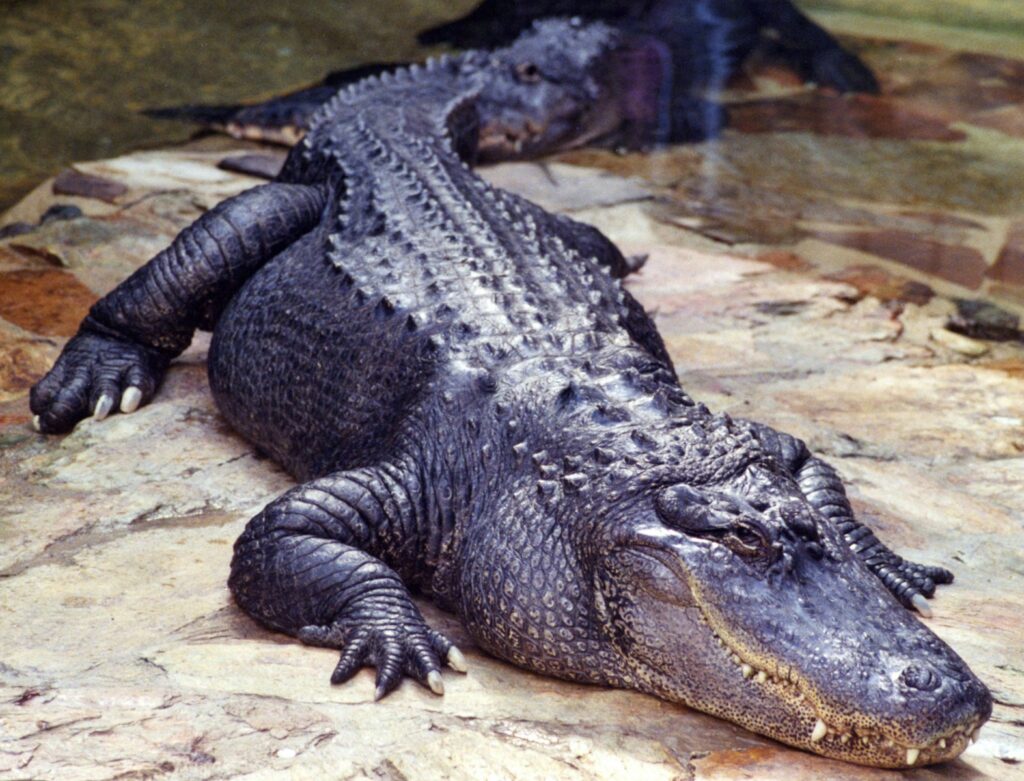
Batrachopus grandis belonged to a group called crocodylomorphs, the broader evolutionary family that includes modern crocodiles and their ancestors. However, this creature existed during a time when crocodilian evolution was experimenting with diverse body plans and ecological niches. Unlike today’s crocodiles, which evolved for a semi-aquatic ambush lifestyle with sprawling limbs, many early crocodylomorphs were fully terrestrial, and some even evolved to become herbivores. Batrachopus grandis represents a particularly specialized branch that adapted to life as an active terrestrial predator. Its upright stance allowed for more efficient locomotion on land, potentially giving it advantages in pursuing prey or covering territory. This adaptation exemplifies convergent evolution, wherein similar traits evolve independently in unrelated lineages, as it developed a posture reminiscent of theropod dinosaurs despite having a completely different evolutionary history.
Anatomical Peculiarities: The T-Rex Comparison

The comparison to Tyrannosaurus rex serves as an accessible reference point, though important distinctions exist between these creatures separated by millions of years of evolution. Like T. rex, Batrachopus grandis had legs positioned directly under its body rather than splayed to the sides, creating what scientists call a “parasagittal” stance. The fossilized footprints reveal distinctive heel-to-toe impressions indicating an upright walking gait similar to dinosaurs and modern mammals. The creature’s feet themselves were crocodilian in basic structure but showed adaptations for weight-bearing from above rather than the side. While modern crocodiles have ankle joints that primarily allow rotation, Batrachopus likely had ankle structures that facilitated more forward and backward movement—a critical adaptation for upright walking. This unusual combination of features makes it a remarkable example of how evolution can produce unexpected body plans that don’t fit neatly into our categorical expectations.
Size and Physical Characteristics

Based on the size of its footprints, researchers estimate that Batrachopus grandis reached lengths of approximately 10 to 13 feet (3 to 4 meters)—significantly larger than most of its crocodylomorph relatives from the same period. While this is smaller than the largest modern crocodiles, it would have been an imposing predator in its ecosystem. Its body was likely more streamlined than modern crocodiles, with proportionally longer legs to accommodate its upright stance. The creature’s head probably retained typical crocodilian features, including a long snout filled with conical teeth adapted for seizing prey. Its tail, while still substantial, may have been less massive relative to body size than in modern crocodiles, as it wouldn’t have been used as extensively for swimming propulsion. Unfortunately, complete skeletal remains have not yet been discovered, so many aspects of its appearance must be inferred from the trackways and our understanding of related species.
Habitat and Environment: The Korean Peninsula 120 Million Years Ago

The environment where Batrachopus grandis roamed was strikingly different from today’s Korean landscape. During the Early Cretaceous period, the region experienced a warm, humid climate with seasonal variations and was characterized by extensive river systems, lakes, and lush forests. The Jinju Formation, where the fossils were discovered, preserves evidence of a dynamic ecosystem with abundant water resources. This semi-aquatic environment would have provided diverse hunting opportunities for a predator adapted to move efficiently on land while potentially retaining some swimming capabilities. The fossil record indicates that this prehistoric crocodile shared its habitat with various dinosaurs, pterosaurs, early birds, small mammals, and other reptiles. Unlike modern crocodiles that primarily hunt from water, Batrachopus grandis likely hunted on land, perhaps pursuing prey through the dense Cretaceous undergrowth where its upright stance would have provided advantages in navigating uneven terrain.
Hunting and Dietary Habits

The upright stance and efficient terrestrial locomotion of Batrachopus grandis suggest it was an active hunter rather than an ambush predator like modern crocodiles. Its diet likely consisted of small to medium-sized vertebrates that shared its ecosystem, potentially including early mammals, lizards, and perhaps even smaller dinosaurs. The parasagittal gait would have allowed this predator to pursue prey more effectively over distance, possibly even maintaining moderate speeds for longer periods than sprawling crocodilians. Its jaws and teeth were likely adapted for seizing and holding struggling prey, though without complete skull fossils, the specific dental adaptations remain somewhat speculative. Some researchers propose that Batrachopus grandis might have employed hunting strategies more similar to theropod dinosaurs than to modern crocodiles, potentially working in coordinated groups or employing sustained pursuit hunting tactics rather than the explosive short bursts typical of today’s crocodilians.
Differences From Modern Crocodilians
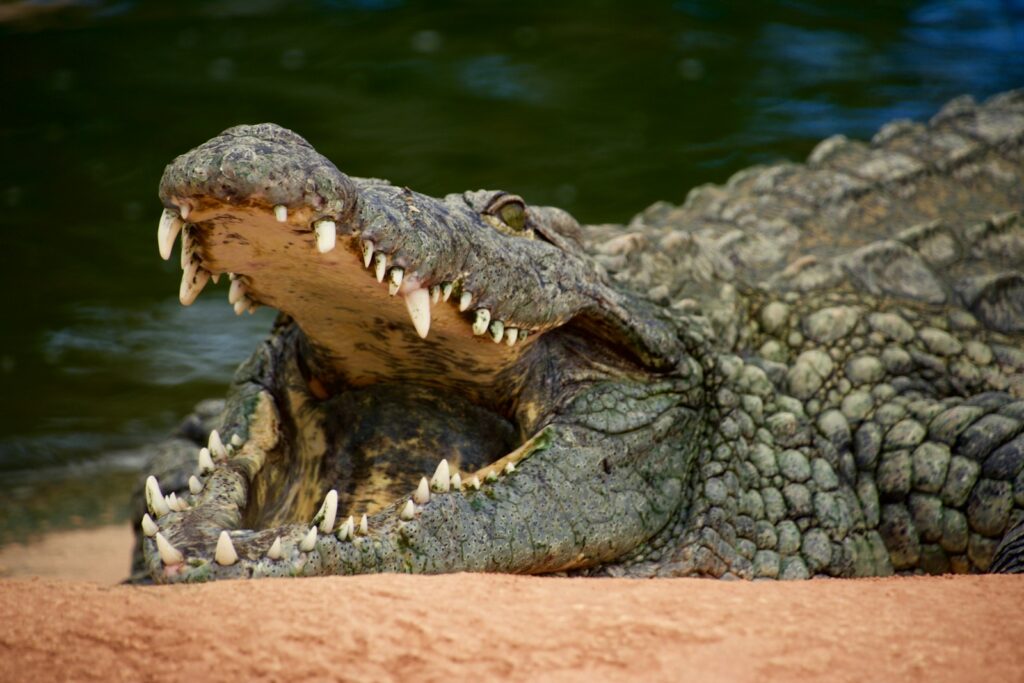
The gulf between Batrachopus grandis and modern crocodiles extends far beyond their contrasting limb postures. Modern crocodilians have evolved for a specialized semi-aquatic lifestyle, with bodies optimized for swimming and ambush hunting. Their sprawling stance makes them relatively slow and inefficient on land, but allows them to move with incredible speed and agility in water. Batrachopus grandis, conversely, appears to have been primarily adapted for terrestrial efficiency. Its respiratory and circulatory systems likely differed significantly from modern crocodiles, potentially featuring more efficient oxygen exchange to support sustained activity on land. Modern crocodiles possess a three-chambered heart with a specialized shunt that allows them to remain submerged for extended periods; Batrachopus might have had cardiovascular adaptations more suited to the constant oxygen demands of terrestrial locomotion. Additionally, while modern crocodiles rely heavily on their massive tails for swimming propulsion and underwater maneuverability, Batrachopus likely used its tail primarily for balance during land movement.
The Significance of Trackway Fossils

The discovery of Batrachopus grandis highlights the crucial scientific importance of ichnofossils—fossilized tracks, traces, and burrows left by ancient organisms. While skeletal remains provide direct evidence of an animal’s anatomy, trackways offer unique insights into how the creature moved and behaved. The footprints of Batrachopus reveal not just its physical structure but its functional biology—how it distributed weight, how it balanced, and how it transferred force through its limbs during locomotion. The consistent pattern and spacing of the tracks demonstrate that the upright posture wasn’t merely possible but was the animal’s normal mode of movement. Analyzing the depth and shape of each footprint provides clues about the substrate consistency, suggesting this crocodile frequently traversed muddy shorelines where its prints could be preserved. The lack of tail drag marks further confirms that the creature held its body well above the ground, unlike modern crocodiles that frequently leave sinuous tail impressions when moving on land.
Convergent Evolution With Dinosaurs

The remarkable similarity between Batrachopus grandis’s locomotion and that of theropod dinosaurs represents one of nature’s most fascinating phenomena: convergent evolution. Despite belonging to entirely separate reptilian lineages that diverged over 240 million years ago, both groups independently evolved an upright, parasagittal stance. This phenomenon occurs when similar environmental pressures lead unrelated organisms to develop comparable adaptations. The benefits of an upright posture include improved breathing efficiency during movement, better heat regulation, and significantly enhanced locomotor performance on land. The convergence is particularly striking because modern crocodilians, despite sharing a common ancestor with Batrachopus, utilize the sprawling posture that was ancestral to reptiles. This evolutionary experiment demonstrates that crocodylomorphs were capable of evolving the biomechanical innovations typically associated with dinosaurs and mammals, though this particular evolutionary pathway ultimately proved to be a dead end as crocodilians continued to specialize in semi-aquatic niches.
Extinction and Evolutionary Dead End

Despite its impressive adaptations, Batrachopus grandis and its upright-walking relatives ultimately disappeared from Earth’s ecosystems. This extinction likely resulted from competition with more specialized terrestrial predators, particularly theropod dinosaurs that had been refining their upright locomotion for millions of years longer. As dinosaurs became increasingly dominant terrestrial predators throughout the Cretaceous period, many crocodylomorph lineages either specialized for aquatic environments or faced extinction. The evolutionary pressures may have favored the ancestral crocodilian body plan for semi-aquatic niches, where sprawling limbs provided advantages for swimming and bottom-walking in water. Climate and ecosystem changes during the Late Cretaceous might have further disadvantaged terrestrial crocodylomorphs as habitats shifted. While Batrachopus grandis represents an evolutionary experiment that didn’t persist, it demonstrates the remarkable plasticity of the crocodylomorph lineage and the diverse body plans they explored before settling into the specialized niche they occupy today.
Recent Scientific Debates
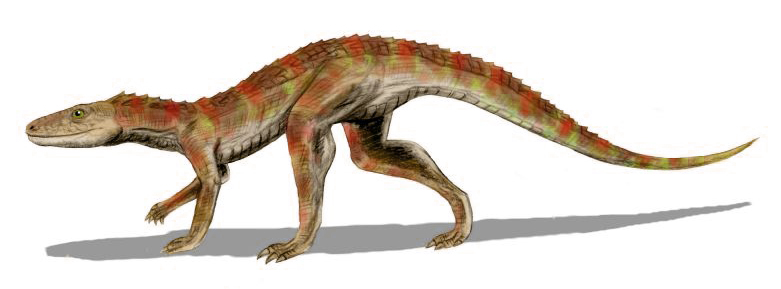
The interpretation of Batrachopus grandis has not been without scientific controversy. Some paleontologists have questioned whether the trackways might have been created by an unknown dinosaur rather than a crocodylomorph, pointing to the unusual combination of features. However, detailed analysis of the foot morphology, particularly the arrangement of toe pads and the distinctive heel structure, strongly supports the crocodylomorph identification. Another debate centers on how completely Batrachopus adopted the upright posture—whether it maintained this stance consistently or shifted between upright and sprawling positions depending on activity. Some researchers have proposed that the creature might have employed different gaits at different speeds, potentially using a more sprawling posture when moving slowly and adopting the upright stance for faster locomotion. Without complete skeletal material, particularly the shoulder and hip girdles that would reveal the full range of possible motions, these questions remain open to ongoing scientific investigation and debate.
Lessons for Understanding Evolutionary Processes
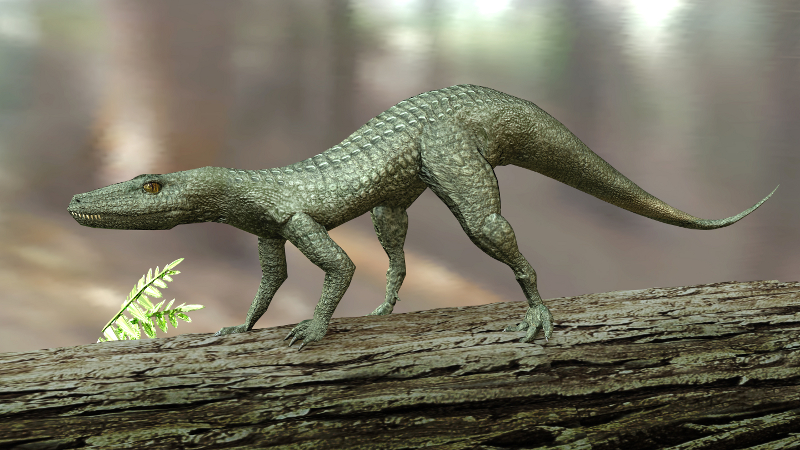
Batrachopus grandis offers profound insights into the complexity and unpredictability of evolutionary processes. It demonstrates that evolution doesn’t follow a linear path toward predetermined outcomes but rather explores diverse possibilities through natural selection acting on random variations. The creature challenges the common misconception that modern animal groups represent the pinnacle of their evolutionary lineage, showing instead that earlier members often explored radical body plans before specialization narrowed their anatomical diversity. This prehistoric crocodile also illustrates how ecological context drives anatomical innovation—the upright stance likely evolved in response to specific selection pressures in its environment that made terrestrial efficiency advantageous. For paleontologists and evolutionary biologists, Batrachopus serves as a powerful reminder to avoid assumptions about extinct animals based solely on their modern relatives. The fossil emphasizes that life’s history contains numerous “experiments” that don’t fit neatly into our categorical thinking, revealing evolution’s remarkable creativity in generating biological diversity.
Future Research Directions

The discovery of Batrachopus grandis has opened numerous avenues for future research into crocodylomorph evolution and diversity. Paleontologists are now actively searching for skeletal remains that might correspond to the trackway maker, which would provide definitive evidence of its anatomical adaptations. Advanced biomechanical modeling using computer simulations could help researchers better understand the locomotive capabilities of this unusual crocodile, potentially revealing its running speed, agility, and energy efficiency compared to both dinosaurs and modern crocodilians. Detailed sedimentological studies of the trackway sites might yield new insights into the specific microhabitats these creatures preferred and their ecological interactions with other species preserved in the same formations. Additionally, reassessment of previously discovered fossils from the same period could potentially identify specimens that might have been misclassified due to their unexpected combination of features. The search continues across Early Cretaceous sites worldwide for evidence of similar crocodylomorphs, which would help establish whether Batrachopus represents a localized adaptation or was part of a more widespread evolutionary radiation.
Conclusion

The prehistoric crocodile with legs like a T-rex represents one of paleontology’s most fascinating discoveries in recent years. Batrachopus grandis challenges our preconceptions about crocodilian evolution and demonstrates the remarkable diversity that existed within this ancient reptilian lineage. Its upright, dinosaur-like stance reveals that crocodylomorphs once explored evolutionary pathways dramatically different from the semi-aquatic specialists we know today. While this particular experiment in crocodilian evolution ultimately proved to be a dead end, it provides crucial insights into the complex and often surprising paths that evolution can take. As research continues, this remarkable creature stands as a reminder that the natural world has always been more diverse and adaptable than we might imagine, with ancient ecosystems inhabited by animals that defy our expectations and categorical thinking.

